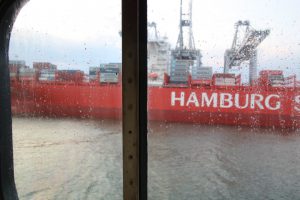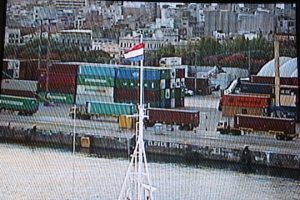We arrived in Montevideo at 7:30 a.m. having travelled 142 nautical miles from Buenos Aires and docked at the end of the market square. Montevideo is the capital of Uruguay, one of the smallest countries in South America. Around the size of England and Wales the country has a population of some 3 million. The city’s Cuidad Vieja (old city) is on a peninsula in the Plate estuary and has narrow streets, squares and a wealth of Spanish colonial architecture.
At the end of the dock is the memorial to the Graf Spee and the so-called battle of the River Plate. The battle is described in great detail in a 2015 book: “Battle of the River Plate” Woodman R. Pen and Sword Naval.
The pocket battleship (fast and small) Admiral Graf Spee was launched in 1936 as the sister ship of the Admiral Scheer launched in 1934. Although war had not been declared the Germans planned to use these two ships as commercial raiders in the Atlantic Ocean. When war was officially declared in 1939 the captains of the two ships knew their duties and carried these out in the South Atlantic away from the European theatre of war. They were closely followed by the German naval tanker Altmark, loaded with ammunition, food, stores and fuel. The ships would rendezvous to restock.
At first the Graf Spee proved to be an efficient raider severely blocking vital supply lines from Argentina, Brazil, South Africa, Australia and the Far East. There were however flaws in the diesel engines which were prone to failure. The hull was not very buoyant and proved to be what mariners call “a wet ship “ in heavy seas which obscured the views from the bridge and conning towers. She did have the B-Dienst radar which gave her good advance data of merchant ships coming her way. More problems occurred as the warm weather of the tropics prevented operations north of 5 degrees south as even the ammunition was getting too warm. The book relates how the captain of the Graf Spee planned his act of deception by converting the Spee to the Scheer. A change of nameplate, grey paint over the initial letters on the bow and some timber modifications which when viewed through binoculars would look like the real thing. However, when the cargo ship SS Clement was captured her crew were taken from the ship by lifeboat to await transfer to the Altmark, the seamen saw the letters AS obliterated by grey paint. The Altmark by now was a prison ship so the news of this deception was not conveyed until the prisoners release later in the war.
The captain of the “new Graf Spee” made for the mouth of the River Plate to sink even more ships but the Royal Navy was now in pursuit. On 13th December 1939 the ship was cornered off Montevideo. There was heavy fire from both sides and HMS Achilles was eventually ordered to withdraw as the battleship entered Montevideo harbour where she stayed until 17th December. If the Spee made a run for it, it risked a fight to the death. In the end her captain slipped out of port, had the crew abandon ship then detonated explosives around the main turrets and ammunition stores. The ship sank and remained visible until 1950 when it finally disappeared beneath the water. An anchor and part of an anti-aircraft gun are at the memorial. To end this chapter of the war the Altmark was finally trapped in Norwegian waters and the 299 British seamen released.










